More actions
| Draconism | |
|---|---|
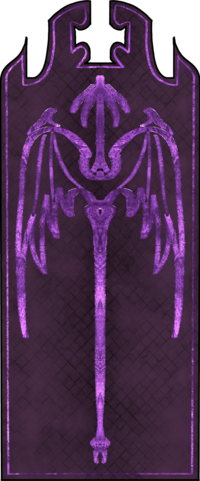 | |
| Religion | |
| Pronunciation | Dra-con-ism. |
| Origins | Start of recorded history |
| Deities | |
| One unified Pantheon with three Factions | |
Draconism as a Religion represents an organized faith of worshiping Dragons. Dragons are a specific class of being, somewhere in between an ancient civilization of immortals, and technicians who keep the basic functions of the world running. While many other Religions are about the Gods teaching mortals virtues and sins and guiding them to live a good life in worship and being, Dragons are less sentimental about worship, and rather take mortals on a journey with them in the operation of the world and preservation of life against outside foes.
Origins
Draconism has invariably existed for all of time, but never quite in the same shape or form. Every cycle of civilization has had some form of Dragon worship, some more popular than others, with different Dragons, and different ideals. The modern version of Draconism first came into being among the early Ailor tribes and the Allorn Empire, which always contained some waning and waxing population of Dragon Cultists. Up until the Cataclysm, Draconism was a deeply disorganized religion with different cults and beliefs held in nearly every country. When Cataclysm happened, many of the Dragons disappeared, some mysteriously, others with a clear message that the time of Dragons was over. This Long Death as it was later referred to, lasted for 300 years, until the Dragons came back one by one, and proclaimed an end to the Long Death, based on a breakdown of the consensus among them about the intentions of passing the Mantle of Creation to mortals. Since coming back, the Dragons have made efforts to organize Draconism into an actual fully fledged Religion, to acknowledge and reward their followers for their belief, even if unlike other Gods they are not strictly incentivized to seek out worship, and sometimes even seem uncomfortable with the idea.
Core Beliefs
Central Message
The central message of the Draconism faith is that there is no true purpose to anything but the continuation and expression of life itself. Draconism acts as a shield against unnatural death, but also as a guarantor of the perpetual cycle of life and death so that reality itself can perpetually experience all the colorful and vibrant expressions of being alive. There are no virtues or vices to be expected of Mortals, with the only real demand that Dragons have, being to obey their rulings towards The Presence, and to preserve life and free will worldwide. Any believer passing into the afterlife has their soul raised up to the cosmos, and turned into one of many countless stars from where the living can gaze up at a memory of them. No separate section with information about the Afterlife will be provided because there is nothing else to be said about it.
Mantle of Creation
The Mantle of Creation is a concept held by Dragons that informs a more technical approach to Draconism. Dragons control the various functions of the world of Aloria, from the cycle of birth and death, to the patterns of weather, material existence, the passage of time, and so forth. The world functions because they continue to make it function, and in some way, that can be cause for mortals to hold them as Gods to give thanks and praise for the reality they have created and enabled. To many, the Dragons are distant and mysterious, because they do not always explain their actions or intentions. The Mantle of Creation has a lot of implications, discussed further down in the Expanded Lore section, but for now only a short introduction will suffice.
Gods and Goddesses
Draconism has one unified pantheon, but the pantheon is split between two opposing factions, ruled over by a neutral mediating Dragon-King who does not take sides but resolves conflicts when they arise. Their opposition is rooted in how both sides want to deal with Demons from any of the Dimensions. All Draconists should worship all Dragons equally (though can choose a patron Dragon), but should also choose one of the two factions:
- The faction of the Great Calm, including the Dragons Marik, Gaia, Orion, Julianus, Daiana, Felicula and Armina, believes that Demons if they follow the laws of life and agree to be bound by Draconist ritual, should be allowed to exist and thrive in the world of Aloria.
- The faction of the Scale Pact, including the Dragons Triton, Aurora, Nox, Cinerius, Umbra, Severena, and Silas, believe that Demons if they follow the laws of life and agree to be bound by Draconist ritual, owe it to mortals to serve eternally as soldiers in the war against other Demons.
Gods and Goddesses
Regulus, the Dragon-King
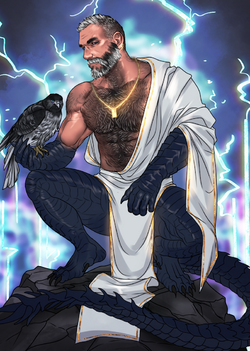
Regulus is the Dragon-King of the entire Draconist pantheon, and acts like an impartial mediator and problem solder within the pantheon, but also as a leadership and authority dragon for his worshipers. Regulus controls the domains of weather and time on Aloria, and is as such often depicted with lightning. His heralds are birds, most commonly his Falcon named Princess. Regulus is prayed to for good weather in travel and fair winds for crops, but also for understanding of future visions and the threads of time which Draconists are often plagued by. He is a patron of leaders, mentors, guides, and any other who seek to help those in need with guidance and words of wisdom, even if his personal guidance is often capricious.
Regulus has a moderating role in the pantheon, as he was born a mortal in the Regalian Empire, but discovered his Dragonsoul at a later point in life. Having lived a life as a relative nobody in the backdrop of an extensive Imperial family, and now saddled with the immortal duties of Godhood, he strikes a fine balance between duty and understanding the impracticalities of faith on the ground. Regulus has deeply personal ambitions and wants, that constantly clash with his responsibilities and leave him conflicted and difficult to understand for outsiders. There are many still around in Regalia who remember him as a mortal.
Triton, the War Dragon
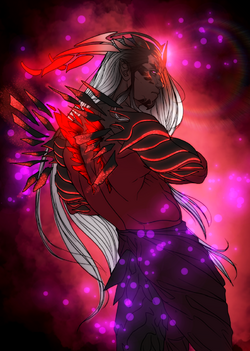
Triton is both Dragon-God and Demon-God at once, a split personality from when the now dead Dragon Caius entered the Void during the first Void Invasion and was fractured. While Caius limped back to Aloria, Triton was trapped in the Void and grew in power there. Triton is often held with distrust because of his attachment to Evolism as a God, but also because his existence in Aloria was predicated on the slow agonizing death of Caius. When Caius did eventually die, Triton was able to break into Aloria, and while Caius himself was succeeded by Cinerius in a reincarnation, Triton assumed the role of War Dragon previously held by Caius. He is worshiped to for good fortune in war and also for victory in personal battle and duels.
Triton is eternally vague or avoidant whenever challenged about his true loyalties. He states one thing to Draconists, and another to Evolists, leading to many circulating theories. Generally though, worshipers hold that more than one version of the truth can be valid, because Gods always seek to expand their power in Aloria by gaining more followers. While the Dragons are generally more distant and haughty than other Gods in this activity, Triton is prone to the vices of the Void and as such seeks more power and influence. Even if some faithful are repulsed by his Void-based nature, they cannot deny his immense power.
Marik, the Leytech Dragon
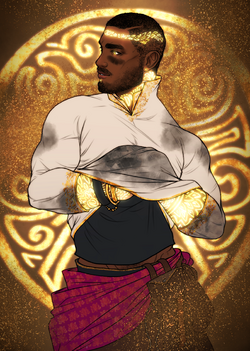
Marik is the lord and master of the Leylines, an intangible network of Dragon power that extends over the world like a vascular system, feeding all of their installations with power and information. Dragons are not omnipotent, and just like other Gods, are bound by the laws of presence and influence around them. Marik's leylines extend the reach of Dragons, allowing them to act globally, for example, allowing Regulus to project weather patterns across the world while never leaving his home in Anglia. Marik also fuels the Leysystem with Soulcores and Unicores, self-operating drones that maintain by now collapsing and decaying infrastructure. Marik is worshiped for good fortune in technological pursuits, and for success in professional employment.
Marik was recently reborn, however some time before the Dragons returned. Marik instead was reincarnated by the enigmatic Primeval the Everwatcher, the high-God of the Unionist faith, and as such, both doubles as a Draconist God and a Unionist God. Marik's position is complicated, because Draconists believe he is foremost Marik the Dragon, while Unionists claim he is foremost their god Al-Asir. Marik himself dubiously avoids the subject, but conspicuously resides among the Skyborn of Ard-al-Nur, while remaining generally absent from Dragon matters, attempting to mend the hostility between Dragonkin and Skyborn.
Gaia, the Nature Dragon
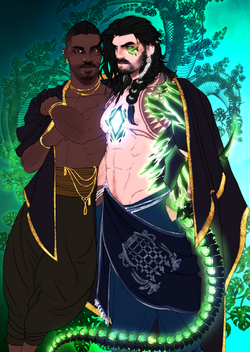
Gaia is the creator Dragon of all things flora in nature. Gaia designs the trees, the plants, the flowers, and all non-sentient life matter that forms the very basic foundations of the food chains all over the world. Gaia is considered a very anti-social Dragon, in the sense that he rarely speaks with mortals, yet is touched to help them by the convictions of his lover. Gaia is worshiped to restore blighted landscapes and environments, but also for protection against the natural dangers of the dense forests, and for plants to clear the way out for anyone lost. It should be noted that not all plants are actually by Gaia's design, as many Gods of other Religions claim the mantle of nature-God, and invariably change plants in their domain to suit them.
Gaia was killed by Teled Elves during the Mage Wars, but his soul was preserved as Dragons never truly die. The current vessel of his Dragonsoul is Iorwerth, once a mortal Aelrrigan Knight from Kintyr who was trapped by the Death Gods to become a servant of the Malefica to save the soul of his lover. Iorwerth acted on behalf of the Malefica for many decades, but was freed by the intervention of mortals in Aloria, and then tasked to carry the Dragonsoul as his burden for serving the Death Gods. He remains scarred by Dark Metal shards embedded in his body, but now enjoys freedom from the control of the Malefica with his lover.
Silas, the Shapter Dragon
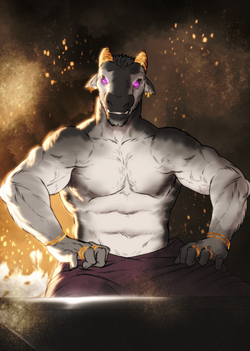
Silas is the Dragon of shaping, making, and crafting. He inspires the combination and processing of raw materials into objects of beauty and function, and so his worshipers pray to him for excellence in their craft. It is said that Silas was the first to strike hammer on anvil, and teach every kindling civilization how to forge bronze and iron. Draconists believe that the first swords used in the first wars on Aloria, were forged in the likeness of his metallic scales, and that the Dragonforges that lie hidden across the world hold ultra-rare ingredients and materials long lost to time by which to craft powerful Artifacts. Indeed, Silas is also the power engine behind all Draconist Artifacts, even if commissioned by other Dragons.
While Aurora is traditionally seen as the Dragon to create all sentient beings of Aloria, this is not actually true in the sense that Silas has actually created all civilization-faring peoples of Aloria. While Aurora is adept at precisely organizing food-chains of complex animal-life, only Silas knows the Elderlaw principles of higher cognitive ability Creation Particles required to form the people of Aloria, while they are born in Aurora's craters, they are shaped by Silas. Silas's most recent magnum Opus, or so it is believed, are the Urlan, a far cry from his first designed Mud-men. Though, he is far more enigmatic than Aurora, and is often forgotten.
Severena, the Protector Dragon
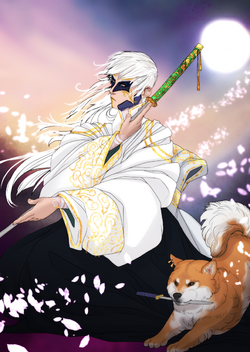
Severena is the Dragon of protection and guidance, a Dragon that has inspired whole civilizations into the act of world-guardianship. She inspires all to shepherd and shield those too weak to defend themselves, and empowers her followers to protect them from harm, most chiefly the Demons who have come to bring ruin to Aloria. While Triton is considered the General to issue commands, Severena is the frontline commander who joins the fray with the Archon and Leytech machines. Triton remains in the shadows with his plots, while Severna brandishes her blades and talons to protect not only her charge, but also those who have chosen to sacrifice their life in the line of duty for Dragons. She is prayed to for protection and liberation from oppression.
Severena did not traditionally die or disappear like the other Dragons at the end of their reign around Cataclysm. Rather, she and her clade of Dragons entered an eternal slumber that froze the Jade Seas around the Zhong Kingdoms, the traditional homeland of the Sihai. This event also created the Jade Walls, massive walls of frozen seawaves that protect the Sihai lands from their periodic Demonic attacks, as massive lumbering beasts called Akula attack from the seas. Lately, the Jade Walls have shown signs of cracking and melting, leading many to fear the imminent awakening of the Dragons, and the disappearing of their protections.
Aurora, the Life Dragon
Nox, the Knowledge Dragon
Orion, the Afterlife Dragon
Julianus, the Wisdom Dragon
Daiana, the Ancestor Dragon
Cinerius, the Passion Dragon
Umbra, the Death Dragon
Felicula, the Arcane Dragon
Armina, the Community Dragon
Priesthood
Priesthood for Draconism is more complicated than one might assume at first glance from a Religion that was effectively dead for 300-odd years while most Dragons were either in slumber, or in a near-death state. At the end of the Immortal War, the Dragons decreed that the Mantle of Creation (the theoretical stewardship over the world's functions) was to pass to mortals, and that they too would become mortal (explanation on why they did this is further below). As this occurred around Cataclysm, Draconism as a Religion was effectively dead for 300 years except for among the Sihai where the Dragons could still be visited, or the Isldar who were deceived. Still, when the Dragons returned centuries later, they found that much of the priesthood had survived their absence and that in some places, the faith had even grown. The Religion had always been considered more of a curiosity by the Dragons, who never asked to be worshiped, or set out to have a Religion specifically ordained by them. They fully expected everyone to give up on the Religion when they left, but the fact they had not, caused a change to occur.
The structures that were still very much in place, were the hierarchy set out before the Immortal War that had more or less survived. At the head of all the priesthood were the Matrons (a non-gendered term) that applied to the single most favored of each Dragon God. Each God had their own Matron, a mortal who would have their favor, and know most personally their wishes and ambitions for the world, and could translate them to the other faithful. This position was often elective, but some Matrons passed their lineage from generation to generation, which became especially common after the Denial of Immortality. The only Matron succession that had not survived, was Regulus's Matron, who was eventually chosen from the Isldar to be Gwenyth Zylmoira, leading the faithful into a new era.
Below the Matrons, are the Dragon Priests. Dragon Priests represent the whole religion, but usually specialize in the teachings of a specific Dragon God as their patron, and emphasize their qualities and teachings above the others. Generally speaking though, Dragon Priests should be aware of all other Dragons just as much, and be able to hold their own in theological discussion on the merits and values of the other Dragons too, but also understand the overarching narrative of Draconism as a whole. It is possible to be a Dragon Priest and hold other occupations, as Dragon Priesthood is more of a personal choice than an ordained position. There is no official academy or place of teaching for Priests, the only real requirement is that each self-ordained priest takes a pilgrimage to the Matron of their Patron God, and seeks approval from them.
Below the Dragon Priests are the Dragon Champions. Unlike Dragon Priests, Dragon Champions do not widely act as priests, they are more akin to lay-priests but hold an extreme emphasis on specific Dragon Gods. Anyone can be a Dragon Champion, it is in most cases self-declared, but 9 out of 10 Dragon Champions are warriors because they enforce the might and will of their Dragon usually by the sword. This may lead to some comical arrangements, with Felicula Dragon Champions forcing participants to have a party and be happy, with the threat of physical harm if they do not. Dragon Champions can administer religious services, but only specifically to their own patron God, while Dragon Priests can perform more general and wide-spread religious services.
Expanded Lore
The Expanded Lore section contains additional contextual information about the Draconist faith. This section is not necessary to read to get a good understanding of the lore, just the background information.
Festivals and Worship
The Draconism Expanded Page contains information on Draconism Holy days (one each month), as well as basic rituals performed by Draconism Priests for the faithful. This Page is useful to read for upcoming festivals, but is not necessary to fully explore unless an event is actually upcoming and pinned to the calendar. The bottom of the page contains information relevant to Draconism Priests.
The Advancement
The Advancement as an event began with the death of Caius. Caius had been suffering from the Void Infection for millennia, and his eventual demise was guaranteed and even foreseen. For all this time, it was Umbra who ordained that the only way to solve Caius's condition, was to remove all Magical things form the world, so that the connection between the Void and Aloria could be severed. Indeed, historical events implied that this was correct, because after each Void Invasion, Caius's condition would improve for some time as most Magic was seeped from the world, only for it to return as Mages became more prevalent. There is some healthy room for discussion to determine whether Umbra was right, whether he was wrong, or whether he obfuscated the truth on purpose. This theory would not imply that Umbra is specifically malicious or treasonous to the Draconic cause, but that he might have stretched the truth to keep the Draconic cause busy with the wrong type of cure, to guarantee Caius's death just to see what would happen if he did die, which would be consistent with his death-god obsession with the beauty of death.
Whatever the motivations or circumstances, the event of Caius's death and Cinerius's rebirth from his corpse was cause enough to call for a full conclave. With the beginning of the conclave, it became evident that Regulus was not satisfied with a partial conclave, and so he called down Orion, something that had not been done for thousands of years. Following this, the conclave was convinced to rescind the punishment of Nox. It had become pretty clear in the past few millennia that being punished was part of Nox's plan all along, and that being trapped in the mirror dimension as he was, that he was difficult to keep tabs on by the other Dragons. His habit to be secretive and have plots detached from the common Draconic cause was considered a liability, and perhaps in part, Nox was proved right by the endless cycles of free-will causing the same outcome one way or another. Indeed, the very reversal of the Denial of Immortality was reason enough to claim that the rhetoric used by Nox to create the Slizzar was at least in part right.
With all the Dragons re-convened, the conclusion was made that the impassioned guidance of the Dragons was in part to blame for the chaotic existence of their followers, and that their unclear and mysterious attitude to the sequence of history in the world, also had a part to play in the repeating cycles of destruction. As such, Regulus decreed that all Dragons should contribute to formulating a dogma, and that the Radicals that had come about because of his chaotic return to power, should all be dismissed. Despite these lofty and ambitious intentions, the conclave wasn't a complete success. The Dragons still could not decide on a common policy towards the Infection, even if they chose a more benign term calling it the Presence instead. While the intention had been to unify all Dragons under one policy, Regulus's mediated middle ground wasn't radical enough for either the pro, or anti-Magic side, and so the conclave was split three ways, which all things considered was an improvement over a 15-way split.
Old Believers
Dragon Types
Dragons are not singular, there exist not just 15 Dragons in the world, but technically hundreds, and even different categories. To make sense of the various categories, this section will explain the differences.
- Dragon-Gods are the leaders of so-called Clades. Clades are groupings of Dragons that are all of the same type. For example, the Blue Clade belongs to Regulus the Blue Dragon. All of these Blue Dragons control time and rain and storm, but only the Dragon God Regulus is considered a God. The other Clade Dragons are still considered divine, but their power is inherited from the Dragon-God, who holds absolute authority. The other Clade Dragons should be considered like right-hands because Dragons are not omnipotent or omniscient, and can't be everywhere at once.
- Clade Dragons are the afore-described right-hands of the Dragons. Clade Dragons do not have a consistent number, for example, Regulus has only 6, while Marik has 30 (though many of them remain dead). Clade Dragons appear identical to their Dragon-Gods, but there is no common trend between what certain Dragons look like. The only true commonality is that all true Dragons are massive, sometimes as large as mountains, and thus compare with the Primeval Beings in size. True Dragons can have four legs, only two, six, or none at all. Sometimes they have wings, other times they do not. Sometimes they are long, or stubby, or slither around.
- Drakon are mortal versions of Dragons that nonetheless live for centuries. It is somewhat unclear if they are directly related to Dragon-Gods or Clade Dragons, or were created to come too close to them in appearance. Drakon always appear like the traditional understanding of a wyvern with two large wings which it can support itself on, two hind legs, a long neck and a long tail. Drakon are large but never quite as massive as true Dragons, being about the size of a Regalia Frigate. Drakon have no inherent Magic, but do have an elemental breath that depends on the Dragon they belong to. For example, Regulus Drakon can breathe lightning, while Cinerius Drakon breathe fire, and Silas Drakon breathe sharp silver shrapnel, and Felicular Drakon breathe ethereal Magic. Drakon are primarily war beasts used by the Dragons to fight Arken and Demons. Only in very rare cases will a Dragon send a Drakon to act as mount for a chosen person for their task.
- Drakes (often also called Wyverns) are mortal versions of Dragons that live for several centuries but are much smaller than Drakon. Wyvern are just larger than a war-horse, allowing them to comfortable carry multiple persons on their back, but not able to tear down whole buildings like Drakon could. Drakes were created specifically as flying mounts for the Archon and Dragon Champions, and usually bond with mortals as their personal mount. Drakes do not possess any Magic, appear with the same appearance traits as Drakon, and also do not have an elemental breath.
- Draconet are small mortal versions of Drakes that are no larger than dog-sized. What their exact purpose was is unclear, unlike Drakes and Drakon they have four legs and thus can move around like most mammals, but rarely fly despite being able to do so. Draconets are occasionally kept as pets by worshipers though they are exceedingly rare to find, and usually have to be raised from an egg to acquire the right calm temperament. Draconets were considered a prized possession during the Allorn Empire, but overhunting of their native populations has effectively driven them to extinction in the wild, with only select eggs being held onto for centuries until they hatch for the right person in unclear conditions.
Dragon or Primeval
To cast aside presumptions, Dragons are distinctly not Primeval. While Dragons rarely speak about the pre-Seraph history and existence of the world, they have made clear statements about the idea that when they first awoke, that the Primeval Beings were already there. The only Primeval Beings that the Dragons have ever spoken about, were the Everwatcher, the Blind One, and the Covenant, though for the Covenant she went by a different name and appearance. Dragons believe Primevals to be more powerful than them, and some speculate that in the eternal cycle of creation, that the Primevals actually created Dragons, who in turn created mortals and other Gods, though this is exceedingly hard to prove. There is effectively no communication between the Dragons and the Primeval Beings. The Everwatcher only speaks to the Vessel of Unionism and does so cryptically, the Blind One is in a state of eternal unconscious binding by its followers to prevent it from awakening, while the Covenant seems lost in some higher state of being that makes her interactions with the world seem more instinctual than calculated. The Dragons urge utter caution when attempting to interact or learn more about the Primeval Beings, because what is unknowable to Dragons, will surely spell doom for the mind of mortals.
God Dreams
Dragons create Gods, flat-out. It is necessary to discuss this topic to dissuade furthering logic that because Dragons create Gods, that other Religions are fake and that Dragons should be worshiped instead as the only correct Gods. This is far from the truth, and actively against the intentions of the Dragons even. To first examine how other Gods are made, they are barely tangentially made by Dragons. When enough people on Aloria wish or crave for something, it is often through the optic of divine protection or saving. People generally gravitate in situations of despair and suffering, to wishing for a higher power to wisk them away and protect them, and this naturally becomes a desire for a savior-god. When enough people wish for this, all that emotional energy is felt by the planet itself, which is Daiana. Daiana dreams, but her dreams are never decided upon by herself, they are affected by the emotional energy that permeates the crust from the people living on it. And so, when enough people wish for a God, Daiana dreams of their desire, and Daiana's dreams become manifested reality. Nearly all Gods are thus born from Daiana's dreams by the template and wish provided by the people. There are some corner cases. For example, some Fornoss Gods were Arken who refracted into Godhood, and some Unionist Gods were made Gods directly by the Primeval Being the Everwatcher, but generally speaking this logic holds true.
It is necessary to express that even though Daiana takes a direct role in the creation of Gods, coupled with the fact that Aurora has indirectly created all species and peoples of Aloria through biological experimentation, that this does not mean anyone owes them their life or obedience or indeed worship. The Dragons primary directive is to create and preserve life, but they take a very apathetic role towards this life after it is created and is able to survive. While the Dragons indirectly aid certain societies by sending Archon or other Dragon forces to fight The Presence, this isn't really to protect specific groups of people, but rather just to counteract The Presence. In many ways, Gods that are dreamed up by Daiana are found family, while Dragons are the actively rejecting family that wants nothing to do with mortals, unless they specifically choose to worship them. Dragons are welcoming to worshipers, but do not demand or expect worship from those who feel stronger kinship with the Gods that were born from their ancestor's wants and needs, and that have always been present to guide them and their ancestors, and will continue to be around for their descendants. This doesn't necessarily stop some Dragon worshipers from acting smug about the technical superiority of Dragons over other Gods, and it is certainly true that some Gods are very weak compared to Dragons and actively hide away from them, but that these persons are never ontologically correct with their attitude.
Trivia
- Draconism is technically the oldest religion, but due to constant changes in its dogma, it is now actually the youngest Religion, being exactly 1 month old at time of this article writing.
- Sometimes non-named Dragons are very important. It was not by ordaining from Regulus that Dragons returned, but due to the rebellion of Renita, one of his subordinate Dragons.
- Dragons should be considered a form of an advanced civilization that has acquired godhood, but inevitably, there are very limited numbers of them. The Gods just happen to be the leaders of the "Clade".
| ||||||||||
| Accreditation | |||||
|---|---|---|---|---|---|
|
| ||||